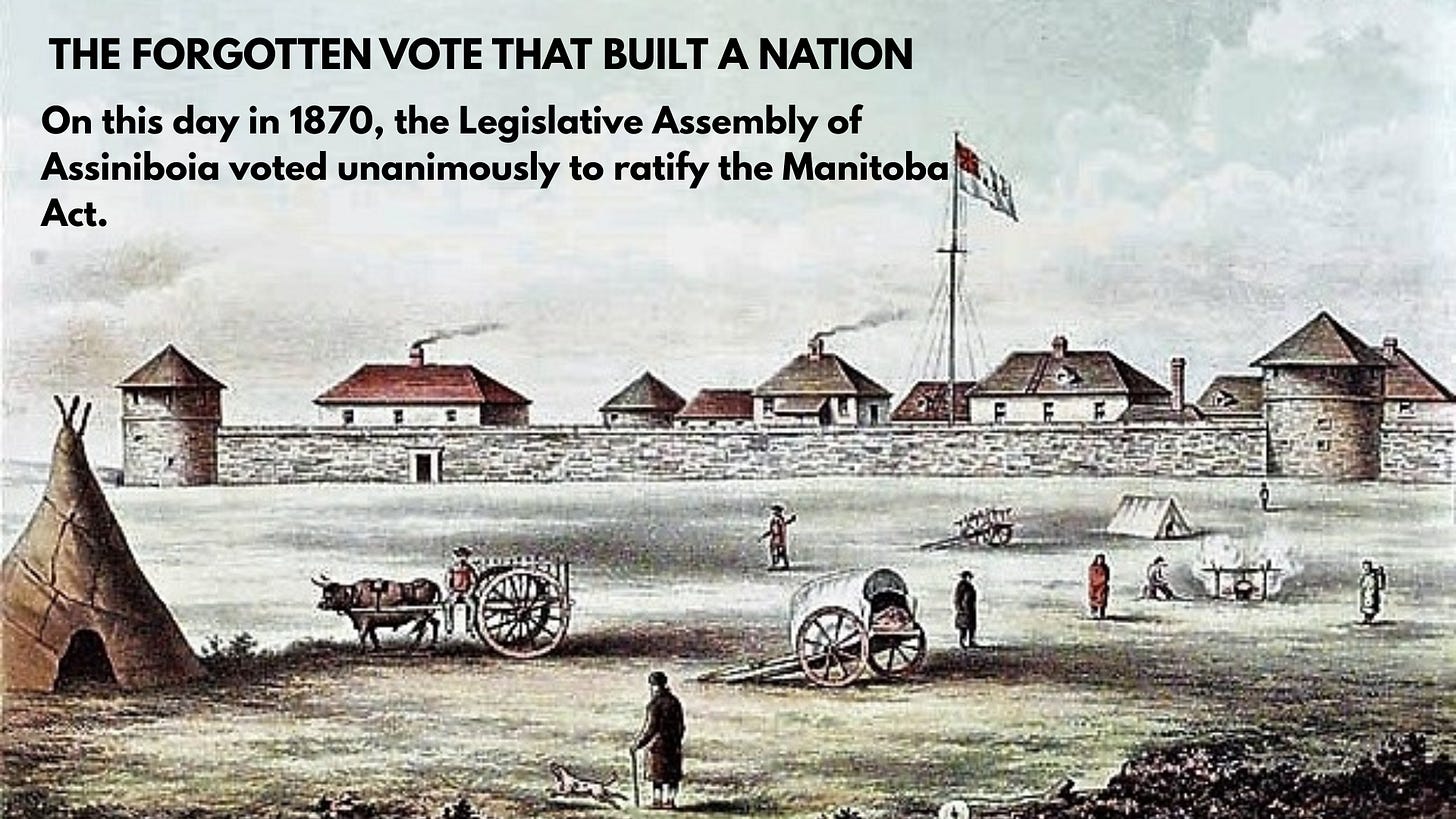On this day in 1870, in the council chamber at Upper Fort Garry, the Legislative Assembly of Assiniboia—under the presidency of Louis Riel—voted unanimously to ratify the Manitoba Act.
It was not a submission.
It was not a surrender.
It was a treaty.
The ratification marked the formal decision of the Red River Métis to join Confederation—not as subjects, but as partners. It affirmed a vision that has guided the Red River Métis for generations: that we are a self-governing people, with the right to define our citizenship, govern our affairs, and stand as equal participants in the life of Canada.
The story of June 24, 1870, is often overlooked in Canadian classrooms. But it deserves recognition as a moment of national consequence.
A Government-to-Government Agreement
Too often, the Manitoba Act is described as a unilateral act of the Canadian Parliament. This is misleading.
As the historical record shows, the Act was the product of intense negotiation between duly empowered Métis delegates—Father Noël-Joseph Ritchot, Alfred Scott, and Judge John Black—and the Canadian government, including Sir John A. Macdonald, Sir George-Étienne Cartier, and Joseph Howe. Their negotiations were complex, and at times confrontational. Canada drafted its own bill. The Métis refused it. They brought forward their List of Rights. Debate ensued. Compromise was reached.
The Manitoba Act was, in effect, a treaty—an agreement between two political entities: the Government of the Provisional Government of Assiniboia and the Dominion of Canada.
This understanding was clearly articulated in the debates of the Legislative Assembly of Assiniboia on June 24. President Riel and the Assembly heard the full report of their delegates. They evaluated the terms. They deliberated on the promises. And, after spirited democratic exchange, they ratified the Act.
As Riel declared that day, “We have seen the Manitoba Act — have heard the report of our delegation — and now we have to proceed to something else. Is it the intention of the House to pronounce on the Manitoba Act?”
The answer was a unanimous “yes.”
A Living Legacy
That spirit of collective decision-making—rooted in democracy, driven by the will of the people—has continued to animate Red River Métis governance.
We saw it in 1967, with the founding of the Manitoba Métis Federation.
We saw it in 2003–2004, when the MMF asserted Métis harvesting rights and adopted its own conservation laws.
We saw it in 2013, when the Supreme Court of Canada recognized the MMF as the representative body of the Red River Métis people in its landmark decision on the Manitoba Land Claim.
And we saw it again in November 2024, when the MMF and the Government of Canada signed the Red River Métis Self-Government Recognition and Implementation Treaty—a modern-day agreement that reaffirms what was recognized in 1870: that the Red River Métis are a self-governing people, with the right to determine our citizenship, hold our elections, and conduct our affairs as a nation.
Confederation, Then and Now
The ratification of the Manitoba Act in 1870 and the ratification by the citizens of the Manitoba Metis Federation of the Self-Government Treaty in 2023–2024 are not isolated events. They are bookends of a long journey—a journey of nationhood, resistance, and renewal.
As President David Chartrand said at the time of the Treaty’s signing:
“We—the Red River Métis—are Canada’s negotiating partner in Confederation and the Founder of the province of Manitoba… We have always known who we are. Despite many attempts to tear us down, we have always been the strong, self-governed Indigenous nation that facilitated Manitoba’s entry into Confederation.”
In 1870, the Red River Métis offered Canada a model: of bilingualism, biculturalism, and Indigenous-led democracy. That offer was too often ignored. But today, through the Treaty, it is being recognized—constitutionally, legally, and historically.
The Work Continues
Much remains to be done. The promises of the Manitoba Act were not fully kept. The land promised to Métis children was mishandled and delayed. The arrival of troops led not to peace but to persecution. And the legacy of that betrayal still echoes today.
But the spirit of that June day—of unity, determination, and faith in both our people and our place in Canada—endures.
The Provisional Government is gone. But its vision lives on.
We remain, in the words of Rev. Ritchot, “a strong people,” capable of distinguishing between those who come in good faith and those who “only come with selfish ends.”
On this anniversary, let us remember: we entered Confederation not as conquered peoples, but as founders of a province. We did not beg to join Canada—we negotiated our way in. We joined because our rights were (presumably) protected, our voices respected, and our identity preserved.
Today, as we implement the modern-day Self-Government Treaty, we carry forward the same torch that was lit at Upper Fort Garry 154 years ago.
Let us hold it high.
Let us honour those who came before us.
Let us build for those who will follow



